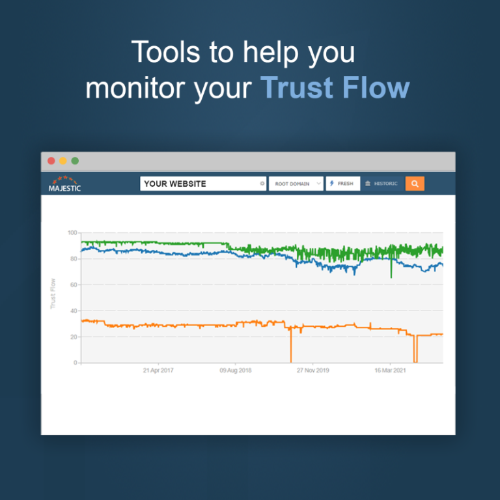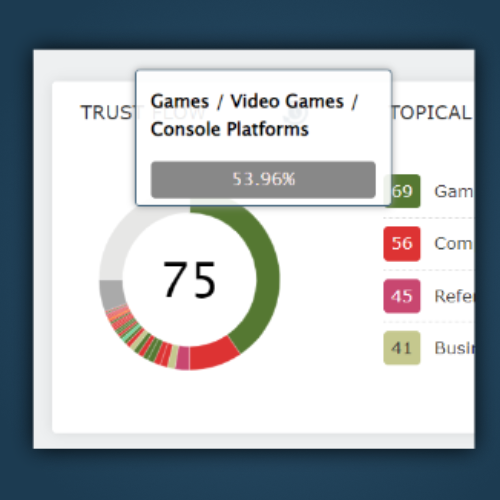Introducing Trust Flow
Looking to understand Majestic Trust Flow? You've come to the right place. Discover what makes Trust Flow different and how it can help you.
Reading time: 5 minutes
What is Trust Flow?
Trust Flow is an SEO vendor metric from Majestic that scores the quality of a website by its backlinks.
Trust Flow is a whole number between 0 and 100. Sites like Google, Facebook and Adobe have high Trust Flow. Sites that have just been registered with little or no backlinks tend to have low Trust Flow. Most sites are somewhere in between.
High Trust Flow scores are difficult to achieve. As Trust Flow increases, it becomes harder to gain more Trust Flow. So, an increase from 5 to 15 is much easier than an increase from 15 to 25.
As a result, there are many more sites with low Trust Flow than sites with high Trust Flow.
What makes Trust Flow different?
Like Page Rank, Trust Flow is calculated at the URL level. Domain-level Trust Flow is calculated by combining all the URL-level scores for that domain.
Trust Flow takes link equity into account. Backlinks from quality, well-linked-to pages tend to pass more Trust Flow than pages of lower quality or with fewer inbound links.

Trust Flow isn’t just about links between sites. Trust Flow takes into account equity from both internal and external links in its calculation.
More than one metric
Many SEO tools have separate scores for web pages and websites. Majestic takes a different approach.
Trust Flow has a complimentary metric, Citation Flow. While Quality inspires Trust Flow, Citation Flow is driven by Quantity.
Both Trust Flow and Citation Flow are calculated at the domain and URL levels. The domain scores are produced by aggregating URL-level scores.
Comparing the TF with CF can yield insights into the quality of links coming into a site.
Are you aware of the quality and authority of the backlinks pointing to your website? Have recent link building efforts attracted low-value spam from guestbooks and forum comments? Trust Flow and Citation Flow help you separate quality backlinks from background noise.
How does Trust Flow differ to backlink counts?
You may wonder why a metric like Trust Flow is needed when SEO tools can count backlinks or referring domains. If I have 20,000 backlinks or 2,000 referring domains, that’s good, right?
The problem with counting links or referring domains is that not all links are created equal! A backlink from an article on the BBC or New York Times is far more valuable to your business than a link from a comment on a local forum.
SEOs and Digital Marketers rely on Trust Flow because it attempts to address this lack of balance in the value of different links on different sites.
How do you use Trust Flow?
Detailed backlink analysis can take a long, long time. That’s because there are lots and lots of links and lots and lots of factors to consider. If you have a lot of backlink analyses to perform, that’s a lot of work. Prioritising this work can help you quickly identify and deal with more critical issues.
Trust Flow is best seen as a tool for data-savvy digital marketing professionals. Trust Flow summarises a huge volume of backlink information into a single 0 – 100 metric. Because there is only one small number to look at, rather than thousands of rows of data, it can help inform the questions you ask.
The dramatic reduction in volume this represents helps you ask directed questions, where the answers can have real-world impact:
- If your competitor has a greater Trust Flow but a similar amount of referring domains, this could mean they have links from more authoritative sites than you. Majestic offers you tools like Clique Hunter to find where these links come from.
- If your Trust Flow drops, it might mean that your website has lost an important backlink, one that could have been the source of qualified referrals. Majestic offers reports to monitor your Trust Flow.
You don’t need to pay to benefit from the insights Trust Flow provides. The Majestic Browser plugin gives you an at-a-glance report on websites directly from your browser. And it’s free.
What can you measure with Trust Flow?
You can use Trust Flow for far more than URLs and domains.
Because many social media apps are built on the web, you can look at posts and handles and measure their Trust Flow.
Majestic Author Explorer makes it easy to find notable journalists and bloggers who might be willing to write about your brand. The Trust Flow of their social handles can help inform your outreach. Author Explorer and Majestic also report on links to your brand's social output. This gives you the ability to track notable social content, and discover output that has gained lasting online commentary.
Is Trust Flow the same as Domain Authority or Domain Rank?
Different SEO tool providers offer different scores – such as DR from Ahrefs and DA from Moz. These scores are calculated differently but try to solve similar problems. Industry insiders refer to these scores as "SEO Vendor metrics". As with so many things in life, some people prefer one metric to another, some like to use a number of metrics from different providers, and others hate them all.
Where vendor metrics become particularly controversial is search. It’s important to note that Google doesn’t use DR, DA or Trust Flow to rank pages.
Google rose to prominence by delivering relevant results based on its proprietary link-based formula, Page Rank. Google has not rested on its laurels. Significant technological improvements have happened over the last few years. Today, the algorithms that rank Google Search results are far more sophisticated.
Despite this increase in sophistication, many SEOs believe that quality backlinks remain an influential part of search
You may be able to see why a skilled SEO might want to use SEO vendor metric as a measure of link building success or as an aide to digital PR and link building. SEO vendor metrics don’t power Google search results. HOWEVER, SEO vendor metrics DO report on the impact of links on your website and your competitor’s websites. This makes vendor metrics, like Trust Flow important tools in the right hands. You should however be mindful of risk if you try to push an SEO vendor metric as a client facing KPI.
What is a good Trust Flow?
An important takeaway: If you aim for 100 Trust Flow, you will be disappointed. Unless you are the chairman of Google, it’s unlikely to be a possibility.
Instead, think of Trust Flow as a relative measure. Use Majestic to compare your Trust Flow with your competitors. Track the Trust Flow of key players in your niche with campaigns. You can even track individual pages, such as your homepage.
A significant community site like Women in Tech SEO may have world-wide reach but have a Trust Flow in the 20s because it is an important resource for a particular industry. It’s unfair to compare it with a site like the Automobile Association because they have a much larger audience. A fairer comparison might be the UK-based Women In PR group, whose site has a Trust Flow of 12 at the time of writing. By looking at relevant competitors you can find the range of Trust Flow relevant to your niche.
However, don’t get hung up on Trust Flow. Use it appropriately. Trust Flow is a great tool in the right hands. As with any tool, use it the wrong way and it could be a distraction rather than a benefit!
Learn more about Trust Flow on the Majestic Blog
The web is big and constantly growing. New pages are being created every second. Trying to quantify every link of our known web is complex, and there are many reasons why your Trust Flow may change
Find out how to set up detailed tracking to monitor the Trust Flow of sites and pages. If Trust Flow and Citation Flow analysis starts and ends with Site Explorer, this post is for you!
What do the different coloured sections mean? And why do the chart slice proportions not seem to match Topical Trust Flow numbers? Read on to work out how you can learn to interpret any Trust Flow chart.
Could we improve this page for you? Please tell us


